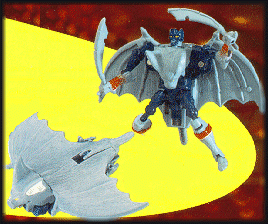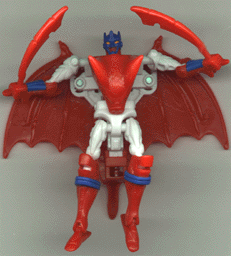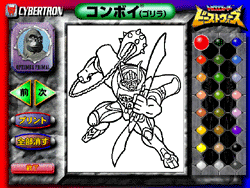 BEAST
WARS: TOY REVIEW
BEAST
WARS: TOY REVIEW
Measuring about 11cm in length with an 11.5cm wingspan.
The moulding is covered with a nice down of fur sculpting. From the top
side, the is almost entirely gray-blue. The eyes are yellow and there are
two white little fangs. The jaw opens and closes revealing a red tongue
and an additional two white fangs. The major flaw with this mode is the
underside. Whilst the wings have great bone and vein moulding, there's
far too much robotic undercarriage.
ROUND 1: The West
Optimus Primal and Megatron came
together in a double pack on card. This set came with a small, badly drawn
and poorly written comic book.
Not worth opening up, really. Although the toy retails for around 13
USD, I managed to pick mine up for 8 USD at KB Toys. I'm glad I didn't
pay full price for this set.
ROUND 2: The East
At first, Convobat (C-6) and Megalligator (D-6) were released as any other Beast Wars Transformer in Japan; available either individually or together in a versus set (VS-6). Other than all the usual stuff (catalogue, instruction booklets, Tech Specs cards etc.) there wasn't much else. Still, beats the hell out of their counterparts across the Pacific. ;)
The only Beast Wars Transformers to have ever been sold on a card (all other Transformers in Japan are boxed). Both Convobat and Megalligator were repainted for this release and came with a CD ROM.

The CD ROM itself has two main options; one is a database with Tech
Specs on various Beast Wars Transformers as well as various footage from
the TV show and TV commercial. The second option is a colouring in programme.
It's basically like a colouring book, except you're using a mouse instead
of crayons and the beauty of it is that you can recolour the same image
again and again...
 (Left):
The colouring programme from the CD ROM itself.
(Left):
The colouring programme from the CD ROM itself.
Most bats are insectivores. Consuming immense quantities of insects, bats play a vital role in balancing insect populations and controlling pests. Certain bats also feed on fruit, pollen and nectare. Vampire bats of tropical America feed on the blood of mammals and large birds. These bats sometimes serve as carriers of rabies.
Bats are found worldwide and large colonies have been known to infest houses and public buildings. There are two suborders of bats, the Megachiroptera (flying foxes and Old World bats) and the Microchiroptera (found worldwide). Only one species of Megachiroptera uses echolocation, the rest are visually orientated and are skeletally primitive. The Microchiroptera all possess the ability to move and hunt by acoustic means. Bats vary greatly in size. The largest being the Pteropus vampyrus has a wingspan of 1.5 metres, while the Phillipine bamboo bat has a wingspan of only 15 millimetres. Bats display variety in colour, fur texture and facial appearance.
The wings of the bat are evolutionary modifications of the forelimbs. The fingers are greatly elongated (except the thumb) and are joined by a membrane extending from the posterior border of the forearm and upper arm down the side of the body to the ankle or foot. The thumb ends in a claw.
The most striking feature is the head. The external ear projects forward and is usually very large and highly mobile. The bat's muzzle is typically rodentlike or foxlike. Many bats have a nose leaf consisting of skin and connective tissue which either surrounds the nostrils or flaps above it. One theory states that this nose leaf is used during echolocation.
The neck is short and the chest and shoulders well muscled and large. The hips and legs are slender. Except for the wings, bats are well furred in shades of gray, tan, brown or black on the back and in lighter shades ventrally.
The sexual cycles of entire bat populations are synchronised, thus mating occurs over a period of weeks. Gestation ranges from 6 weeks to 6 months, depending on species. Pregnant females generally roost in special nurseries. Most births are single, although the brown bat (Eptescius fucus) have twins and the red bat (Lasiurus borealis) can have litters of four.
Almost all bats are nocturnal. Roosting in the day and foraging at night gives them an advantage over sleeping prey and protects them from predators, the Sun and high temperatures. Bats tend to prefer isolated roosts such as caves, crevices, burrows or buildings. However, some bats roost in trees or rocks. Bats are often found in large colonies. Isolated roosts, nocturnal activity and a colonial way of life have greatly contributed to the longevity of bats. Some bats have been known to live over 20 years.
In bats which use echolocation, short high-frequency sound pulses are produced that reflect from objects within their vicinity. The bats listen to the returning echoes and are able to locate prey and obstacles. Highly sensitive ears and greatly developed integration of vocal and auditory centres of the brain are required for this feat. These sound pulses are also used for communication between bats.
Bibliography: Encyclopaedia
Brittanica